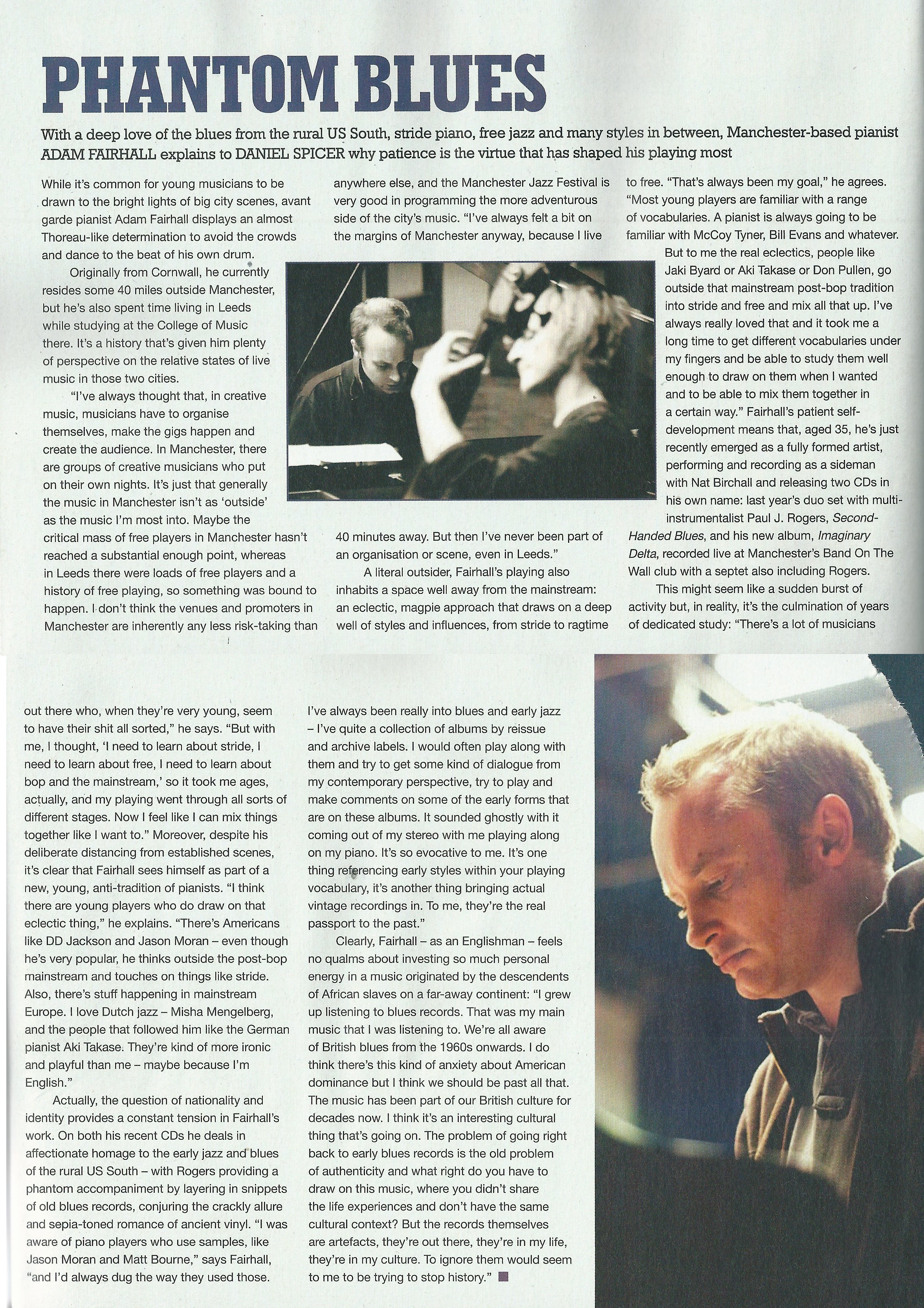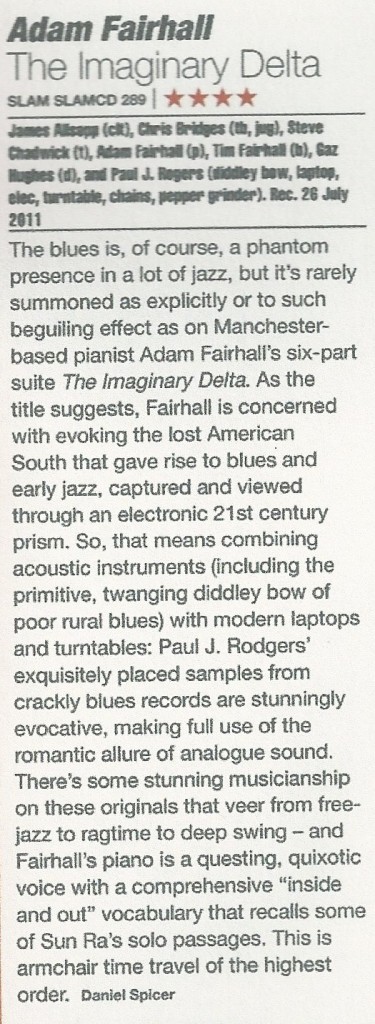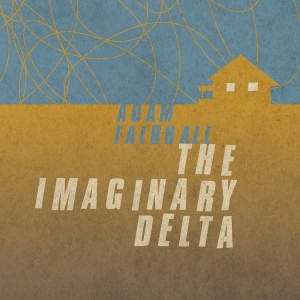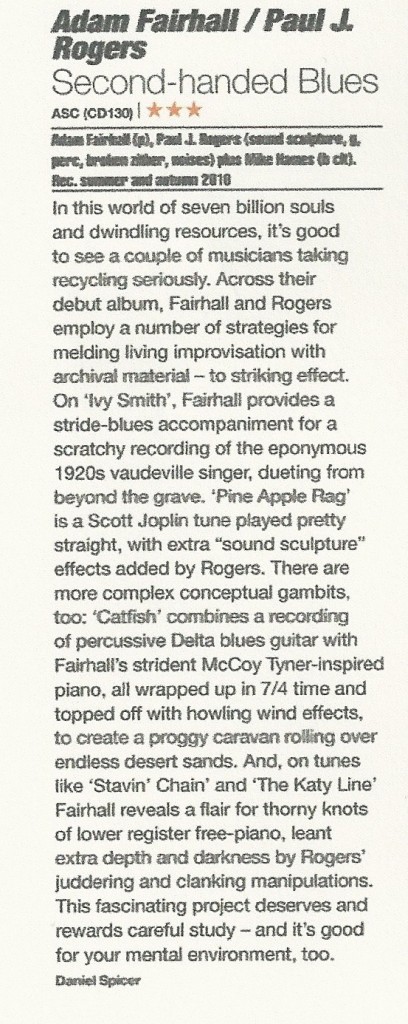Ian Mann www.thejazzmann.com
October 26 2012
This excellent album by Manchester based pianist and composer Adam Fairhall was released in May on George Haslam’s Slam label but with Fairhall due to bring his group to London to perform this material at the 2012 London Jazz Festival in November the time seemed right for me to take a rather belated look at it.
I know Fairhall’s playing through his work with fellow Mancunians Matthew Halsall (trumpet) and Nat Birchall (saxophones), he appears on Halsall’s “On The Go” and Birchall’s “Sacred Dimensions”, both of which have been reviewed elsewhere on this site. He has also been part of Halsall’s touring line up.
But there’s more to Fairhall than just his sideman role. He also works as a solo pianist and runs a trio featuring Tim Fairhall (bass, presumably his brother although I’m not totally certain of this)) and drummer Gaz Hughes. The seeds for “The Imaginary Delta” project would appear to stem from his duo with electronics artist Paul J. Rogers who provides samples of 1920’s blues recordings which Fairhall then merges with more contemporary musical influences such as the piano stylings of McCoy Tyner. Their album “Second Hand Blues” was released on ASC Records in 2011.See Fairhall’s website http://www.adamfairhall.co.uk for further information on this and his other projects.
“The Imaginary Delta” grew out of his experiments with Rogers and was commissioned by the 2011 Manchester Jazz Festival. The album was recorded live at the city’s Band on the Wall venue on 26th July 2011 and features an expanded line up of Fairhall on piano plus the horns of James Allsopp on clarinets, Chris Bridges on trombone and jug, and Steve Chadwick, leader of cult Manchester band the Magic Hat Ensemble, on trumpet. His regular trio colleagues Tim Fairhall (bass) and Gaz Hughes (drums) complete the rhythm team with Rogers acting as the wild card contributing the modern musical accessories of laptop, electronic processing and turntables alongside arcane instruments such as the diddley bow and novelty items including chains and pepper grinder. In this sense he’s a kind of Leafcutter John figure. Steve Mead, the Artistic Director of Manchester jazz festival spoke of Fairhall’s ambition to “draw upon the early language of jazz and make it speak to us in the 21st century”. Acclaim for the festival performance and subsequent live album (the latter mixed on an analogue desk to preserve the warmth of the live sound) has been virtually unanimous resulting in an invitation to bring this music to the capital as part of the 2012 LJF.
“The Imaginary Delta” is a suite in six parts that blends Rogers’ early blues sources with the writing of Fairhall. Sampled sounds are merged with real time instruments to create a fascinating patchwork of ancient and modern. Opener “Baptist Prayer Meeting” contains a sample of George “Bullet” Williams “Middlin’ Blues” and features Rogers on diddley bow (now you know where Mr. McDaniel got his stage name from) alongside the more conventional jazz instrumentation. The piece grows out of Rogers’ samples and diddley bow to embrace a more contemporary modal sound with rich, deep bass clarinet voicings from Allsopp and Tyner style piano from Adam Fairhall. The sound generated by the three horns is pleasingly full and the piece eventually concludes with a passage of solo piano.
“Sedalia Rag” combines the rhythms and syncopations of ragtime with more contemporary free jazz leanings. Rogers’ electronic whooshes and bleeps contrast nicely with the more conventional jazz instrumentation in a series of free jazz exchanges informed by the spirit of the past. There’s a prolonged passage for the trio of the Fairhalls and Hughes with Tim’s muscular bass stalking Adam’s piano as the chatter of Hughes’ drums provides both punctuation and comment. When the horns return the piece becomes more obviously a “rag”, albeit one filtered through the prism of Charles Mingus and the whole sixties free jazz movement.
“Arabian Fantasy” includes a highly effective sample of Ivy Smith singing Cow Cow Davenport’s “Cincinnati Southern Blues” which is grafted seamlessly onto a seductive, undulating modal theme. Allsopp’s subtly bluesy clarinet solo, Bridges’ growling trombone and Chadwick’s slow burning trumpet feature then evoke the spirit of New Orleans but in a wholly contemporary setting.
“Tutwiler Train Stomp” begins with spooky free jazz sounds but Fairhall’s piano gradually leads the piece into an exuberant romp with some terrific horn interplay, Chadwick’s brassy trumpet contrasting superbly Allsopp’s woody low register bass clarinet. The horns also get the chance to solo at length with Allsopp going first sketching sinuously mesmerising bass clarinet lines above the propulsive rhythms of bassist Tim Fairhall and drummer Gaz Hughes. Bridges then rasps away fruitily on trombone before Fairhall brings it all home with some torrential piano runs. The solos are punctuated by squalling collective passages and the piece eventually fades away to end as mysteriously as it began. Quite a railroad trip.
Not surprisingly “Victoria Spivey” features the sampled voice of the lady in question singing “Nightmare Blues”. The piece begins with the crackle of Rogers’ electrics and a sound like ghostly pump organ, perhaps meant to simulate the steam whistles of the Mississippi river boats. Fairhall’s piano delicately wanders around these atmosphere setting effects before settling into an authentic blues pattern onto which the disembodied voice of Spivey is superimposed. Chadwick’s trumpet slurs and growls offer suitable embellishment and the other horns are subsequently added to the mix. The band keep the blues mood going after Spivey is faded out with Chadwick and Allsopp on bass clarinet contributing pithy statements. There’s also an extended solo bass feature for the consistently excellent Tim Fairhall who later enters into dialogue with Bridges with Chadwick, Allsopp and Hughes later joining in as the blues edges closer to free jazz. Adam Fairhall picks up the blues baton again with a solo piano feature that embraces a number of jazz and blues styles. The ghost of Victoria Spivey then returns to sing us out.
The closing “Harlem Fast Shout” sees the group tearing it up in uproarious fashion beginning in Cotton Club era Ellington style before veering off into a free jazz squall and back again. The mood is exuberant and playful with trumpeter Chadwick’s fiery opening solo an undoubted highlight.
“The Imaginary Delta” is a superbly realised project with Adam Fairhall as the fulcrum but all the musicians involved play well and make significant contributions. The merging of different jazz and blues styles and of divergent technologies is seamlessly done and the entiree album represents a remarkably coherent whole. Fairhall is to be congratulated for his vision which blends his extensive knowledge of jazz and blues styles with strong compositional skills to present an entity which is entirely convincing. “The Imaginary Delta” conjures up the ghosts of not only of the musicians sampled on the soundtrack but also those of Ellington, Mingus, Tyner, Ayler and more and (to paraphrase Steve Mead) makes their spirits speak to a 21st century jazz audience.
4 out of 5 stars
Dave Sumner (Allaboutjazz Download of the Day Editor), Birdistheworm.com, Best of 2012 (thus Far) List
August 27 2012
It is a remarkable challenge to create a piece that is both innovative and nostalgic, one that blends the influences of the past with a vision of the future, and to do it without sanitizing one or the other. On The Imaginary Delta, UK pianist Adam Fairhall does exactly that.
Originally commissioned by the Manchester Jazz Festival (and premiered live at Band On The Wall), Fairhall harnesses the disparate sounds of an ensemble built around obscure, traditional, and modern instruments and technology, and sets them upon a suite of compositions informed by traditional and modern musics alike. Instruments like piano, trombone, clarinets, trumpet, drums, and bass team up with jug, didley bow, sampling, turntables, and effects, for a series of tunes informed by the blues, ragtime, stride, free jazz, modern and traditional jazz.
And Fairhall doesn’t just play it straight. These are deconstructed jazz tunes that leave the heart intact. The influences are just that… influences. This is modern, forward-thinking music that just so happens to conjure up voices from the past. In many ways, the artist most logically referenced by this album is Charles Mingus, who himself, also made experimental innovative music that, also, was heavily indebted to traditional jazz and blues. It as if Fairhall isn’t channeling the music of Mingus, so much as he is the spirit with which Mingus gave life to his music.
Now, about that music…
Your album personnel: Adam Fairhall (piano), Chris Bridges (trombone, jug), Steve Chadwick (trumpet), James Allsopp (clarinets), Tim Fairhall (bass), Gaz Hughes (drums), and Paul J Rogers (laptop, turntable, diddley bow).
The opening track starts with the processed sampling of an old recording, used as an interlude to the menacing, yet boisterous “Baptist Prayer Meeting.” As the samples diminish into the background, the other musicians enter the recording with bass clarinet sneers and stormy skies piano. Drums rattle off stark warnings, and diddley bow adds a percussive element that doesn’t cheer the mood. The is Jazz composition as balled-up fist.
But the thing of it is, that initial menace gives way to a joyous energy as the band surges more emphatically into the tune, trumpets and trombones lending their voice to the rising tide of sound. When the tide quickly recedes, and the sound returns to the opening menace… well, it just doesn’t sound that ominous anymore. Beauty need not always source from pretty sounds. There is beauty in scars, in shouts, in growls, in ferocity… just so long it’s arranged properly and played with heart and soul. The song ends as it began, quiet, eerie, and the samples of sounds from another time.
Second track “Sedalia Rag” opens with prancing horns and the scratch of turntables. The two forces wrestle, and become as one, their sounds indistinguishable from one another and from their moments of individualism. Hints of traditional ragtime peek out from the free form nature of the tune, especially if the ear follows the breadcrumbs laid out by Fairhall’s piano (most distinctive in the second half of the tune). But, again, Fairhall’s incorporation of those elements into the composition, ultimately, serve to emphasize its modernity, not its ties to the past.
On “Arabian Fantasy,” the mix of slow blues and sampled vocals is equal parts warm and haunting, like hearing the voice of a dearly departed from beyond the grave. Pace picks up with some nice solo sections, especially from trombone.
Fourth track “Tutwiler Train Stomp” is a nice blowing session tune. Bass clarinet takes the spotlight, both on its own and when matched with the higher pitched trumpet. The tune begins with effects, but the traditional instruments take over. The trumpet section is particularly riveting.
Fifth track “Victoria Spivey” begins with a repeated sample of skewed piano. It’s the type of unsettling sound one would expect to hear on a (indie-rock) Mark Linkous song. Fairhall begins playing over it, and adds an element of elegance to the proceeding. Then vocals are sampled in, with Fairhall’s piano and Bridges’ trombone playing over it. The rest of the ensemble slowly files in, adding quiet accompaniment. The tune takes several sharp turns in tempo and style, but ends the way it began, with Fairhall’s piano and the sampled vocals. It’s a nice bit of cohesion to a tune that showed many facets.
Album ends with “Harlem Fast Shout,” a hopping tune that conjures images of dance floors filled with Friday Night revelers and musicians on the bandstand playing into the wee hours of the night.
Nearly three months back, I mentioned in my brief synopsis of this album for eMusic that this is “An album of outstanding scope and vision.” Now, three months later, and plenty more listens under my belt, the truth of that statement hasn’t lost any of its strength. The Imaginary Delta is a stunning achievement.






